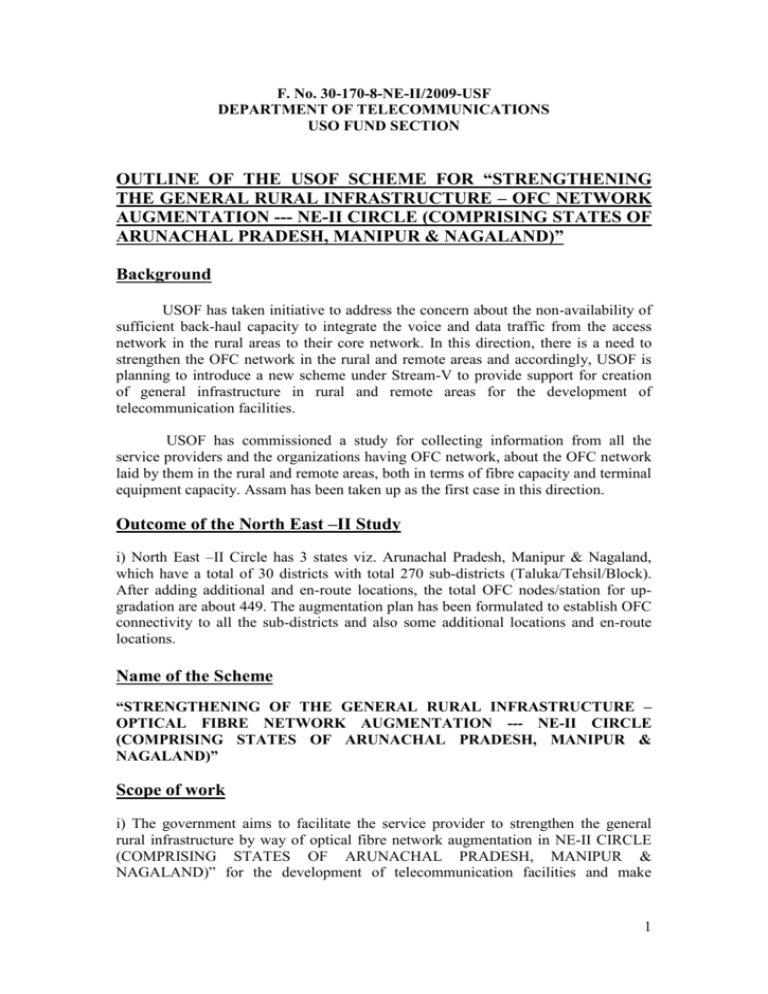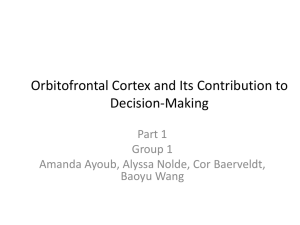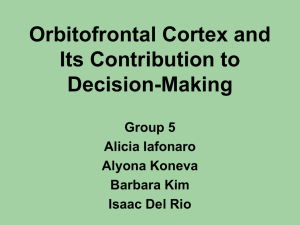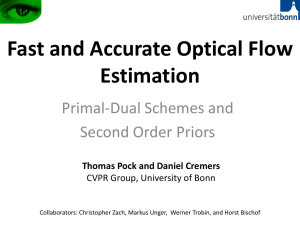Outline of Darft Scheme for OFC Network Augmentation On
advertisement

F. No. 30-170-8-NE-II/2009-USF DEPARTMENT OF TELECOMMUNICATIONS USO FUND SECTION OUTLINE OF THE USOF SCHEME FOR “STRENGTHENING THE GENERAL RURAL INFRASTRUCTURE – OFC NETWORK AUGMENTATION --- NE-II CIRCLE (COMPRISING STATES OF ARUNACHAL PRADESH, MANIPUR & NAGALAND)” Background USOF has taken initiative to address the concern about the non-availability of sufficient back-haul capacity to integrate the voice and data traffic from the access network in the rural areas to their core network. In this direction, there is a need to strengthen the OFC network in the rural and remote areas and accordingly, USOF is planning to introduce a new scheme under Stream-V to provide support for creation of general infrastructure in rural and remote areas for the development of telecommunication facilities. USOF has commissioned a study for collecting information from all the service providers and the organizations having OFC network, about the OFC network laid by them in the rural and remote areas, both in terms of fibre capacity and terminal equipment capacity. Assam has been taken up as the first case in this direction. Outcome of the North East –II Study i) North East –II Circle has 3 states viz. Arunachal Pradesh, Manipur & Nagaland, which have a total of 30 districts with total 270 sub-districts (Taluka/Tehsil/Block). After adding additional and en-route locations, the total OFC nodes/station for upgradation are about 449. The augmentation plan has been formulated to establish OFC connectivity to all the sub-districts and also some additional locations and en-route locations. Name of the Scheme “STRENGTHENING OF THE GENERAL RURAL INFRASTRUCTURE – OPTICAL FIBRE NETWORK AUGMENTATION --- NE-II CIRCLE (COMPRISING STATES OF ARUNACHAL PRADESH, MANIPUR & NAGALAND)” Scope of work i) The government aims to facilitate the service provider to strengthen the general rural infrastructure by way of optical fibre network augmentation in NE-II CIRCLE (COMPRISING STATES OF ARUNACHAL PRADESH, MANIPUR & NAGALAND)” for the development of telecommunication facilities and make 1 available the network capacity to other service providers on sharing basis at the rates and modality recommended by TRAI/DOT/USOF. ii) It is focused on extending optical fibre connectivity up to the sub-district HQ. iii) The USPs shall be required to undertake the scheme on BOO (i.e. build, own and operate) model. The USP will build, operate and own the network. iv) The outcome of the scheme in NE-II will be an integrated Optical Fibre ring/star/mesh robust network with all features provided for the traffic protection. The network shall consist of the existing, up-graded and the new created nodes by deploying appropriate technology in intra-district transport network that will provide cost-effective high capacity in the network to carry TDM/IP/Ethernet/ATM traffic. This network shall also meet the futuristic requirement in terms of technology and the demand for various applications/ services. Capacity Creation and Coverage i) The present scheme shall ensure all the SDHQ stations and other Nodes (about 449 in number) on OFC connectivity. ii) All such nodes shall be on Self-healing ring protection. iii) 2.5 Gbps (min) OFC network capacity, expandable to 10 Gbps, shall be created in each ring. iv) Average total interface capacity (minimum) per node shall be 155 Mbps, expandable to the maximum capacity on demand. Deliverables i) The USP shall provide augmented/expanded OFC network district-wise. ii) Replace the old PDH equipment with or install new proven technology equipment suited for legacy TDM traffic with scope for accommodating the future packet based traffic, wherever required. iii) Install and commission the new proven technology equipment suited for legacy TDM traffic with scope for accommodating the future packet based traffic, wherever required. iv) Shall lay & commission 24 F optical fibre cable to bring the targeted nodes on OFC network, and to ensure cable route diversity on all nodes (including en-route & new nodes). v) Shall upgrade the power wherever required vi) All SDHQ nodes, en-route location nodes and new location nodes shall be connected on OFC ring connectivity with DHQ. 2 vii) All intra-district rings shall be interconnected. viii) Optical line interface equipment with add-drop features TDM/IP/Ethernet/ATM traffic shall be installed at all the nodes. to carry ix) All nodes in the OFC ring shall have self-healing ring protection feature. x) All nodes in the OFC ring shall have cable route diversity. xi) Not more than 6 – 8 nodes to be connected on a single ring to allow for adequate drop/insert interface capacity for rural/remote traffic at the node after allowing for protection capacity overhead. xii) Each ring to have capacity for digital transport of integrated voice, data and video signals shall be at-least 2.5 Gbps, expandable to 10Gbps. xiii) Each node shall have a minimum add-drop capacity of 155 Mbps, expandable to the maximum capacity on demand. Eligible bidders License conditions i) The BSOs/UASLs/CMSPs/NLDOs and short listed IP-IIs are eligible to bid for the Scheme in a Service Area for which they hold a License from DOT. Experience conditions ii) The bidder shall have suitable experience, preferably in terms of the proposed OF Cable route kilometres and the number of Optical Equipment Nodes. The bidder would have a minimum experience of 500 km OFC & 50 optical nodes (where each optical node is of 155 Mbps/equivalent or higher capacity). Financial Conditions ii) EMBG: The EMBG for the instant project shall be worked out based on the Finance Ministry guidelines. iii) PBG: The PBG value shall be kept as 10% of the benchmark value of subsidy for the instant project. It shall be quoted as an absolute amount. Bidding Process i) The bids will be invited for the whole NE-II CIRCLE (COMPRISING STATES OF ARUNACHAL PRADESH, MANIPUR & NAGALAND)”. ii) Single stage bidding shall be adopted. iii) The eligible bidder shall quote at par or less than the bench mark. 3 iv) The rate quoted by the lowest bidder shall be the Representative Rate for NE-II as a whole. v) The district wise RRs will then be established according to the pre-determined percentage share of each district in the NE-II benchmark Roll out Obligation/Period i) The completion of the whole project, as per terms and conditions, within the specified time period of 24 months. Other Obligations i) The USP shall share the bandwidth, created in the network after augmentation, with other service providers as per the terms and conditions specified in the tender document. ii) A percentage of the created capacity (less then 50%, exact figure to be arrived at after financial modeling) shall be retained by the successful bidder for carrying its existing as well as future projected traffic. iii) Balance percentage of the created capacity (more then 50%, exact figure to be arrived at after financial modeling) shall be shared with other service providers. iv) The successful bidder shall provide bandwidth on the lease rental charge at reduced rates from the prevailing TRAI rates, which shall be prescribed in the Tender Document. v) The sharing arrangement shall be mandatory during the validity of the agreement. vi) The successful bidder shall not levy on the other service providers any other charges including rental for space/power. vii) The successful bidder shall not be responsible for supply and installation of any equipment if required by the other service provider to carry the bandwidth to its destination. viii) The successful bidder shall not be responsible towards the end customers of the other service providers. Note: The lease rental charges, arrived at, shall be such as to meet the operating expenses which are recurring in nature. It happens to be lower than the prevailing TRAI rates. Bench Mark for subsidy 4 i) In accordance with the USOF Rules, the subsidy benchmark would be a percentage of capital recovery where capital recovery, i.e. the aggregate of depreciation, interest on debt and return on equity on the capital cost as worked out proportionately and annualized over the period for which support is to be provided from the Fund. ii) To arrive at the percentage of capital recovery to be subsidized by USOF, the capital recovery amount to be adjusted for the anticipated revenue streams during the subsidy period. Also the revenue calculation takes into consideration the discounted tariffs mandated during the subsidy period. iii) In order to calculate the district-wise subsidy rate for NE-II Circle, a difficulty index to be used to moderate district-wise capital costs of the project implementation. Further, revenue streams to be moderated by taking into account the variations in the level of economic development, population and per capita income etc across districts. Subsidy Disbursement Subsidy disbursement is envisaged to be made in the following three stages:i) An upfront amount of the total Representative Rate (RR) for each district (exact figure to be arrived at after financial modeling) shall be paid upon commissioning of the district. This amount shall be paid on self- certification as per the prescribed format by the successful bidder. ii) A percentage of the district-wise subsidy (exact figure to be arrived at after financial modeling) shall be paid in equated annual installments (a percentage of the subsidy (RR) for each district) over a specified period, following the successful completion and certification (by the Designated Monitoring Agency) of work completion for that district. iii) The balance subsidy (RR) for NE-II Service Area (exact figure to be arrived at after financial modeling), as a whole, shall be paid on successful completion and certification (by the Designated Monitoring Agency) of completion of work for all the districts of NE-II Service Area. Validity period of the Agreement The agreement shall be valid for seven years. -----------------------------------------END ------------------------------------- 5







